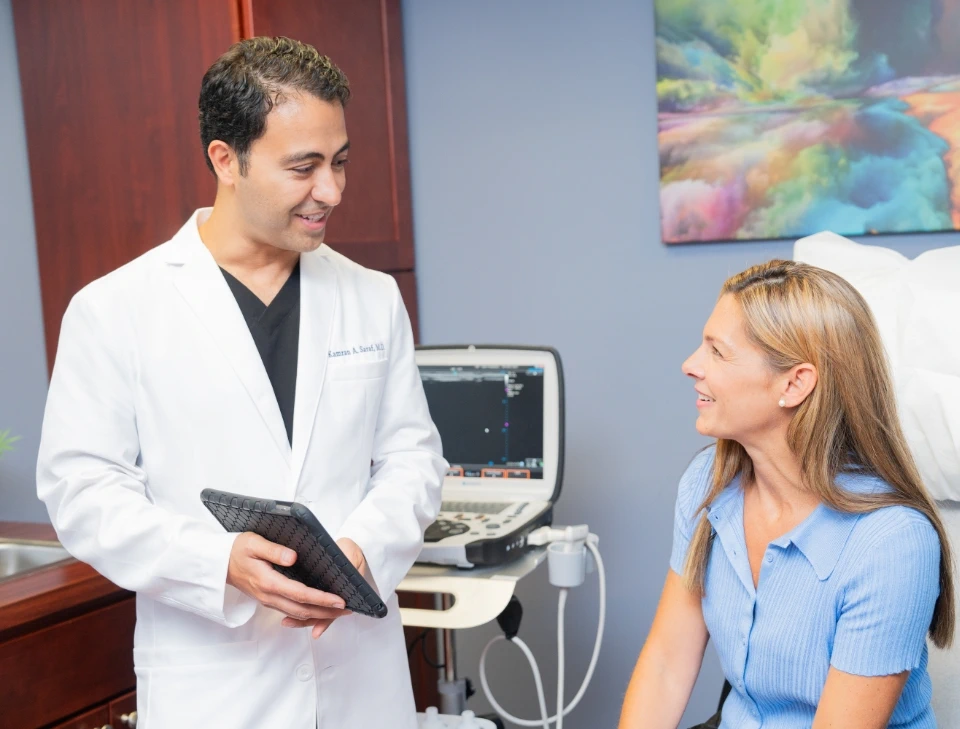Vein mapping ultrasound concludes within 30 minutes!
Vein mapping is a diagnostic procedure used to identify vein disease. The procedure involves the use of special ultrasound equipment to create a map of the blood flow in the veins. The mapping process is used to diagnose chronic venous insufficiency, a condition in which the veins are unable to pump blood back to the heart, leading to the accumulation of blood in the leg veins and the eventual formation of spider veins and varicose veins.

Vein mapping ultrasound is a non-invasive diagnostic procedure performed on an outpatient basis. During the vein screening session, the patient lies on a table, and a special gel is applied to the skin. The ultrasound transducer is then placed on the skin, and sound waves are used to create a map of the blood flow in the veins. The vein mapping process takes approximately 30 minutes to complete.
Once the map is created, the vein doctor can identify any areas of blockage or narrowing in the veins. The vein doctor can also identify the saphenous vein responsible for your vein problems and curate a personalized, minimally invasive vein treatment plan. If you have the signs and symptoms of chronic venous insufficiency, such as leg heaviness, leg swelling, spider veins, and varicose veins, you must contact a vein doctor who performs vein screening.

Vein Treatment Clinic is led by board-certified and Harvard-trained vein doctors specializing in cutting-edge diagnostic techniques and treatments for vein disease. Our vein doctors perform thorough evaluations to diagnose the root cause of your vein problems and offer the best minimally invasive treatment options that conclude within an hour, involve no downtime, and allow you to resume your daily activities and work immediately.
You can find our vein doctors at our state-of-the-art vein treatment clinics in San Diego, San Jose, Maryland, New York City, Long Island, and New Jersey. If you’re in or around the Beltway, you can find our vein treatment clinic in Bethesda, Maryland, just outside of Washington, DC. Please schedule an appointment to initiate your vein care journey.
Do you have spider veins, varicose veins, or leg heaviness? You may need vein mapping!
Chronic venous insufficiency (CVI) is a condition in which your veins have trouble sending blood back to your heart. When blood doesn’t flow properly, it can pool in your veins and cause them to swell. This can lead to spider veins, varicose veins, and leg heaviness. There are several signs and symptoms of vein disease, including spider veins, varicose veins, leg heaviness, swelling in your ankles and feet, cramping or pain in your legs, itching or burning in your legs, and restless legs.
If you have any of the above signs and symptoms, your vein doctor may recommend an ultrasound diagnosis. Duplex ultrasound is a non-invasive diagnostic tool that uses sound waves to create a map of your veins. To prepare for your ultrasound, your doctor will likely ask you to wear loose-fitting clothing, following which the ultrasound device will deliver sound waves into your legs to visualize the blood flow in your leg veins. This is the most effective diagnostic test for the signs and symptoms of chronic venous insufficiency.
If you notice any of the signs and symptoms of vein disease, you may need a vein mapping ultrasound!
What happens after my vein screening?
Your doctor will review the results of your vein mapping and discuss your minimally invasive treatment options. Together, you will develop a personalized treatment plan that is tailored to your specific condition and symptoms. The specific treatments that are recommended will depend on the severity of your condition, but they may include radiofrequency ablation, endovenous laser ablation, sclerotherapy, venaseal, ambulatory phlebectomy, or a combination of these treatments.
Identifying vein disease early is important so that you can begin treatment before the condition worsens and becomes more difficult to treat.
If you identify vein disease, what are my treatment options?
Radiofrequency Ablation
Radiofrequency ablation is a minimally invasive treatment for chronic venous insufficiency. In this procedure, a small catheter is inserted into the vein, and radiofrequency energy is delivered to the vein wall, which heats up and damages the vein. This causes the vein to close and the blood to be redirected to other veins. The procedure takes about an hour, and you will be able to go home the same day.
Endovenous Laser Ablation
Endovenous laser ablation is a minimally invasive procedure that uses laser energy to close off the affected veins. Endovenous laser ablation is performed using a thin, flexible laser fiber that’s inserted into the vein through a small incision in the skin. The laser energy is then delivered to the vein, causing it to collapse and close off.
VenaSeal
VenaSeal is a minimally invasive procedure that involves channeling medical adhesives into the diseased vein to seal its walls shut. The diseased vein hardens into scar tissues and is eventually reabsorbed by the body, and the accumulated blood reroutes into healthier veins.
Ambulatory Phlebectomy
Ambulatory phlebectomy is a minimally invasive procedure used to remove varicose veins. The procedure is performed using a small surgical instrument called a phlebectomy hook or a phlebectomy needle. The phlebectomy hook is inserted into the vein through a small incision in the skin to remove the vein. Ambulatory phlebectomy can be used to remove veins that are larger than those that can be treated with sclerotherapy.
Sclerotherapy
Sclerotherapy is an incredibly effective treatment for spider veins. Sclerotherapy involves injecting a sclerosant solution directly into the spider veins, which causes them to collapse and fade away. The entire process usually takes less than an hour, and the results are usually visible within a few weeks.








